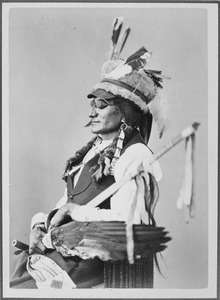Sihasapa

The Sihásapa or Blackfoot Sioux are a division of the Lakota people, Titonwan, or Teton.
Sihásapa is the Lakota word for "Blackfoot", whereas Siksiká has the same meaning in the Blackfoot language. As a result, the Sihásapa have the same English name as the Blackfoot Confederacy, and the nations are sometimes confused with one another.
The Sihásapa lived in the western Dakotas on the Great Plains, and consequently are among the Plains Indians. Their official residence today is the Standing Rock Reservation[1] in North and South Dakota and the Cheyenne River Reservation in South Dakota, home also to the Itazipco (No Bows), the Minneconjou (People Who Live Near Water) and Oohenumpa (Two Kettle), all bands of the Lakota.
Bands
In 1880, John Grass provided a list of the bands (tiyospaye) of the Sihasapa:
- Sihasapa-Hkcha or Sihasapa qtca (“Real Blackfoot”)
- Kangi-shun Pegnake or Kanxicu pegnake (“Crow Feather Hair Ornaments” or “Wear raven feathers in their hair”)
- Glaglahecha or Glagla heca (“Slovenly”, “untidy” or “Too lazy to tie their moccasins”)
- Wazhazha or Wajaje (“Osage”), Kill Eagle’s Band
- Hohe (“Rebels, i.e. Assiniboine”)
- Wamnuga Owin or Wamnugaoin (“Cowrie-Shell Earrings” or “Shell ear ornaments or Pendants”)
Famous Sihásapa
- Charging Thunder (1877–1929). Traveled to Salford, England at age twenty-six as part of Buffalo Bill's Wild West Show in 1903 and remained in London when the show left town. He married Josephine, an American horse trainer who had just given birth to their first child, Bessie, and together they settled in Darwen, before moving to Gorton. His name was changed to George Edward Williams, after registering with the British immigration authorities to enable him to find work. Williams worked at the Belle Vue Zoo as an elephant keeper for many years. He died from pneumonia at age fifty-two on July 28, 1929. His interment was in Gorton's Cemetery.[2]
- John Grass
- Kill Eagle
- Crawler
Notes
- ↑ National Archives, Kansas City 1977. "Standing Rock Agency Record of Rations Issued 1885". Standing Rock Agency Rations Issue to Heads of Families by Bands 1885 (in English and Lakota). RG 75 Records of the Bureau of Indian Affairs Standing Rock Agency, Fort Yates, North Dakota Roll 5A. Retrieved 10 December 2015.
- ↑ "My grandad Charging Thunder". BBC. January 20, 2006. Retrieved August 21, 2012.
References
- Anderson, Harry H. "An Investigation of the Early Bands of the Saone Group of Teton Sioux." Washington Academy of Sciences Journal 46, no. 3 (1956): 87-94.
- Robinson, Doane. "A History of the Dakota or Sioux Indians from Their Earliest Traditions and First Contact with White Men to the Final Settlement of the Last of Them Upon Reservations and Consequent Abandonment of the Old Tribal Life." South Dakota Historical Collections 2, Part 2 (1904): 1-523.
External links
- "Blackfoot Indian Tribe History". Retrieved 2012-01-14.